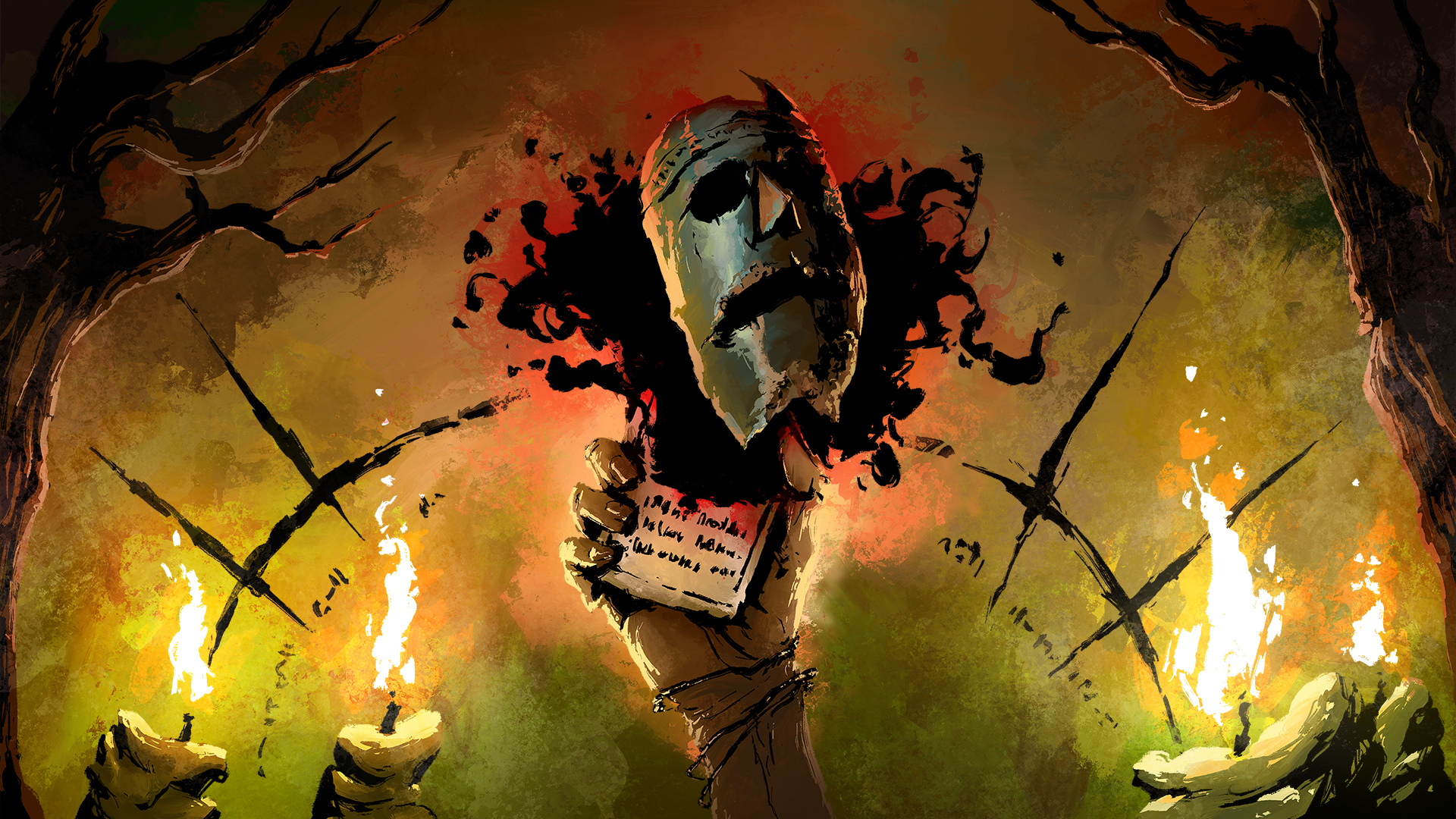As I stalk through the corn fields, I hear the distant rumble of The Devourer oxymoronically nearby. I’ve spent 15 minutes carefully, not arduously, creeping through the village, harvesting over 100 ambrosia. I’m so close to the exit gate I can smell the sweet taste of victory. All of a sudden, my lamp is snuffed out, I hear a roar, and The Devourer spawns out of bile a meter away from me.
He detects me instantly, and my remaining 10 vigor is no match. I groan in despair and relent at all the tension suddenly released.
Harvest Hunt is a horror rogue-lite which straddles the line between unnerving pressure and solemn frustration. The hunter vs hunted trope excels in its best moments, but a little too often it relies on tricks that aren’t always fair, or satisfying to overcome. There’s an excellent seed that’s been planted for horror fans, but it needs some nutrients and attention to grow into a compelling horror harvest.
A Combine Harvester… of Ambrosia
Harvest Hunt is set up in a traditional rogue-lite design. A terrifying presence known as The Devourer plagues the fields of Luna Nova. The townsfolk stumble upon an effigy that is seemingly linked to the foul presence, notably through its creepy mask. Funnily enough, it’s alarmingly similar to the mask the villagers also must don in order to repel the force of horrifying nature.
To this end, each character must embark on a harvest of Ambrosia. A most bountiful delicacy, the nominated five avatars that enter the fields must accrue a minimum amount to fend off the creature. Five characters, five nights each. It’s like Five Nights At Freddy’s, only with less animatronics and more cult-induced demonic entities. So, basically the same thing, right?
Right off the bat, Harvest Hunt sets up a rather enticing mystery. What is The Devourer? Why are these five wardens selected in particular? Who is the narrator who seemingly writes notes in the present, talking about them in the past tense? Lots of questions, and answers you can only gain by facing the night and The Devourer itself.
As you play each night, you’ll unlock various notes and information entries that flesh out the backstory and compelling folklore. The resolution to the overall story is relatively limited, owing to the lack of any kind of dialogue or character interaction. Despite this, the spooky inspiration behind the concept is expertly crafted and well-developed, which made it fun to slowly unravel.
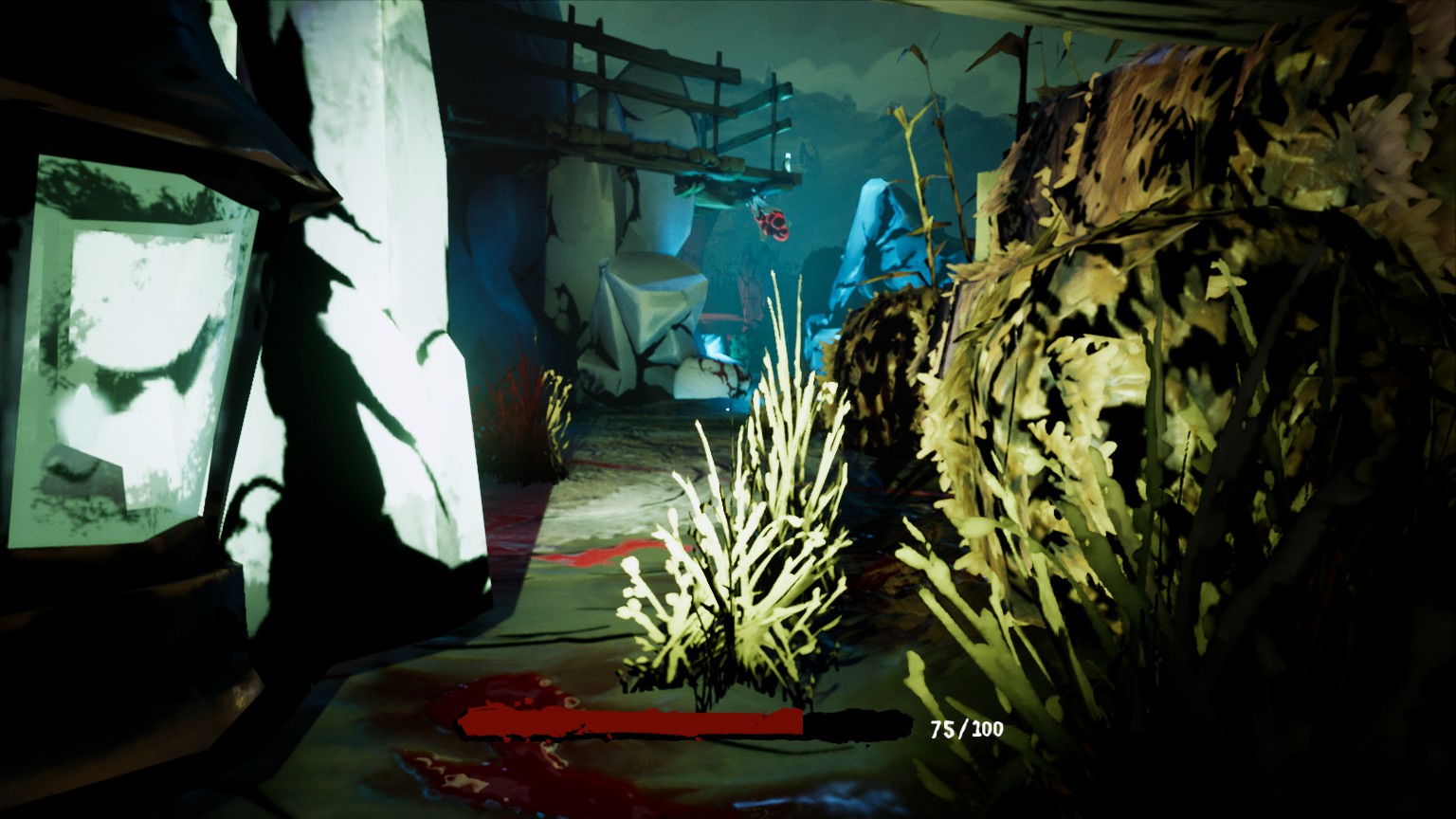
Seeds of Evil
Less fortunately for our poor wardens, escaping The Devourer’s wrath requires willingly entering the fields upon which it torments. Harvest Hunt has a surprisingly simple approach to core gameplay. You must acquire spikes of Ambrosia dotted around a farm-based map, avoiding the attention of the ever-present creature of doom. Collecting is easy enough, but preventing detection certainly isn’t.
Of course, Harvest Hunt has more tricks up its sleeve. Fiends will appear across the map – eyeballs, effigies, water beasties and the like. Should they spot you, they’ll inflict damage or worse yet, summon The Devourer. Did I mention that taking too long allows the giant void of happiness to corrupt the Ambrosia you’re trying to collect? Yeah, it can do that.
I quickly learned to almost always be crouched, but also always moving. Be too reckless and you’ll be offed very quickly. Be too slow and you’ll barely collect anything of note. This balance keeps every “match” tense and moving at a decent pace. There’s no timer, but the pressure to collect higher amounts of Ambrosia adds a natural tension superbly.
I did find there to be a couple of issues, however. The first is that running the same map 25 times just for one harvest moon means repetition becomes a problem. The map isn’t especially massive and after just a couple of runs, you’ll have gotten the swing of it. Secondly, The Devourer has some, shall we say, cheaper tricks that undermine some of the careful balancing of the stakes.
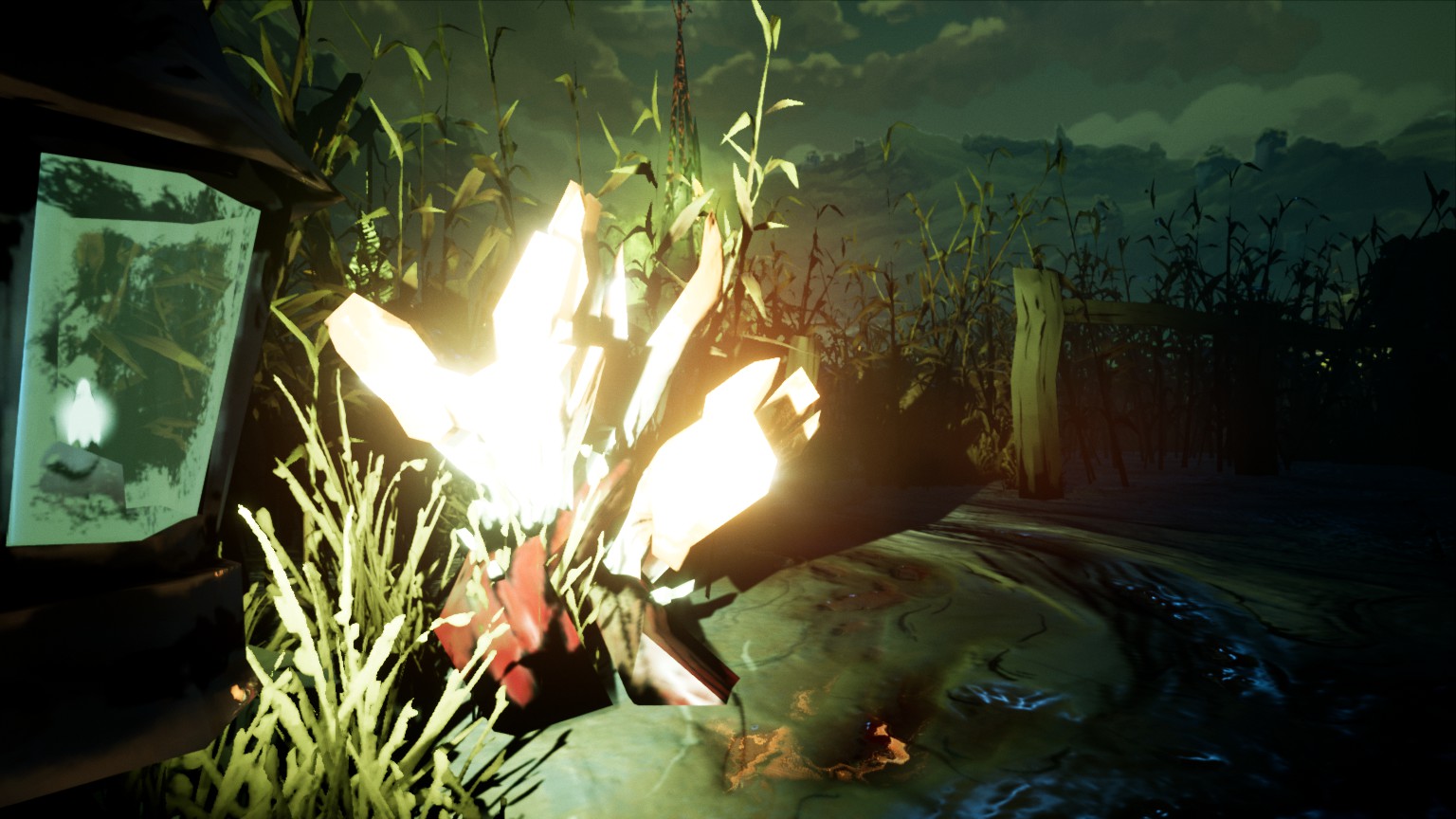
Scream of The Crop
The Devourer’s detection of the player is a bit unpredictable. At times it could spot me seemingly leagues away, other times it couldn’t spot my gleaming (turned off) lamp while literally touching my hitbox. As I mentioned in the introduction, it has a tendency of just spawning on you at random occurrences. This would be fine, if some areas of the map weren’t completely barren of cover and there was a tell in the lead up. But, there isn’t, which makes it feel a bit cheap.
Even with all of that said, there’s an undeniable level of tension the game manages to sustain night after night. The dilemma of when to run for an exit and when to push on for more Ambrosia establishes that key risk-reward rogue-lite dopamine hit. Harvest Hunt also nails the use of various modifiers to change up the difficulty on every attempt.
Over the course of a moon cycle, you’ll accrue village cards (temporary, character run-only buffs), village fortifications (kept for an entire cycle) and whisper cards. Whispers add a single boon, such as having no Fiends on the map, alongside a single debuff, such as the water being poisonous. Each playable character and The Devourer will have a unique attribute card for each run too, creating variety for the threat it poses.
When the cards turned in my favour, it was a glorious blessing. For example, on one run I cancelled out the calamity whisper card with a fortification, allowing me to bring a hatchet to a scaring fight. Another would have boosted the Fiends’ abilities, only for me to draw no Fiends on the map. The variety is impressive and it leads to massive variations in challenge, which I found to be great.
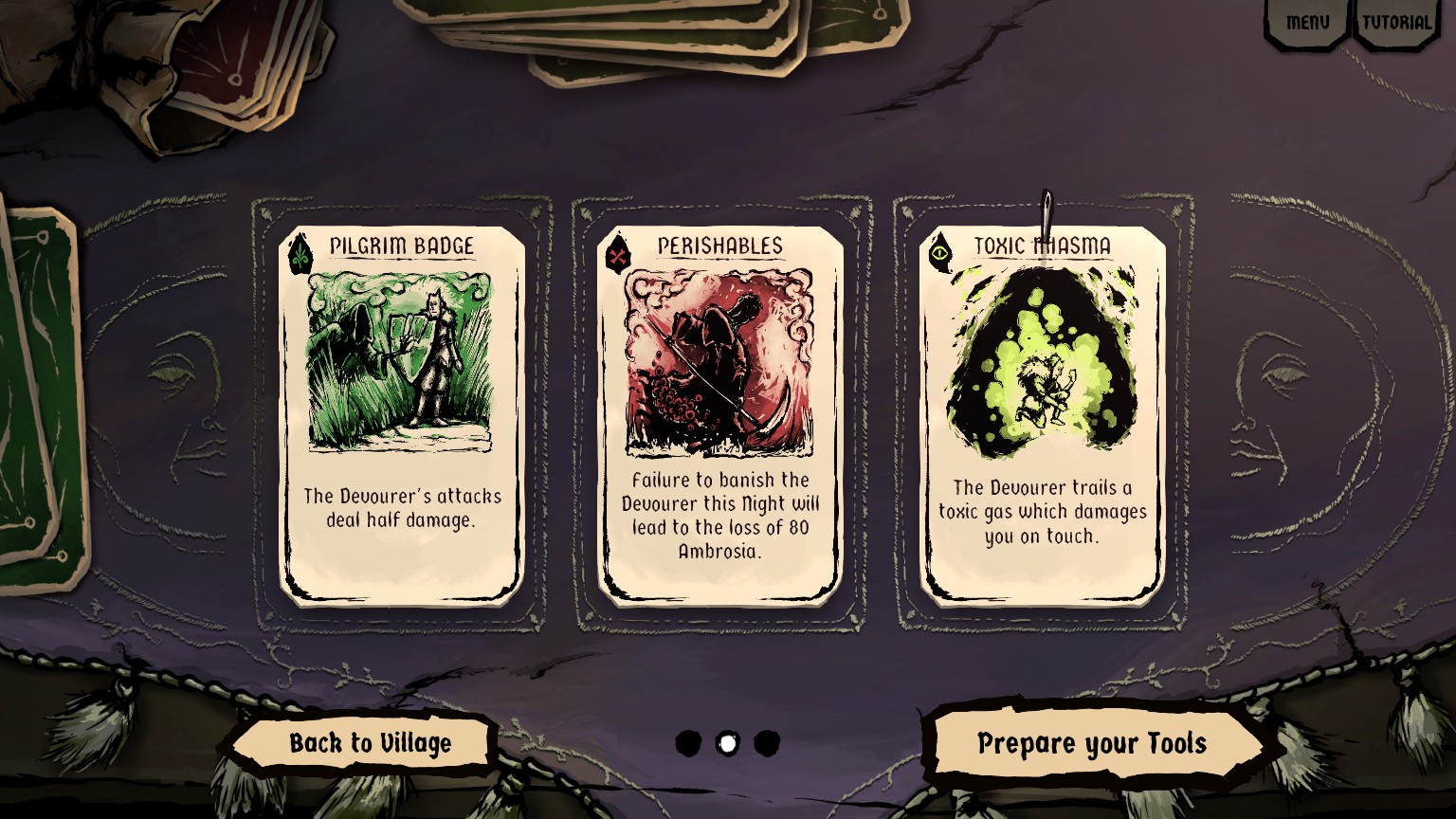
Blood Is In The Air
Depending on your cards and skilful play, you may find yourself caught and killed fairly often. Luckily, dying on one night doesn’t end that character’s five-night run. Instead, you’re punished with no Ambrosia and no village card to choose from, making subsequent nights harder. Should you need to make up a shortfall (or unlike me, if you’re ballsy), you can attempt to banish the creature.
Doing so provides a massive boost of Ambrosia, but also ends the night. On a typical level, you’ll need to gain three fragments, which are gained by using tools to damage The Devourer. Most are close range, require multiple hits, or require a decent sacrifice of vigor. At this point, a compelling sandbox of decisions should probably have opened up. Unfortunately, I never really found this the case.
While a hatchet can always gain a fragment in one hit, giving up 35 of your 100 vigor to start a level made it feel like a glass cannon choice. More often than not, I fell back on the cheaper alternatives, that wouldn’t mean my immediate death. Alternatively, I just relied on stealth to run and collect and hoped the teleporting RNG nonsense wouldn’t scupper me.
Sure, if the cards fell in my favour, I’d take a couple more risks, but it never felt like an actual weighing up of a tough decision. If the cards were bad-neutral, I went with stealth, if they were good, I went with slightly more aggressive stealth. I’d love to say this didn’t work, but it really did. In three hours I’d cleared the moon cycle with each character and hit credits, which felt a bit underwhelming as a result.
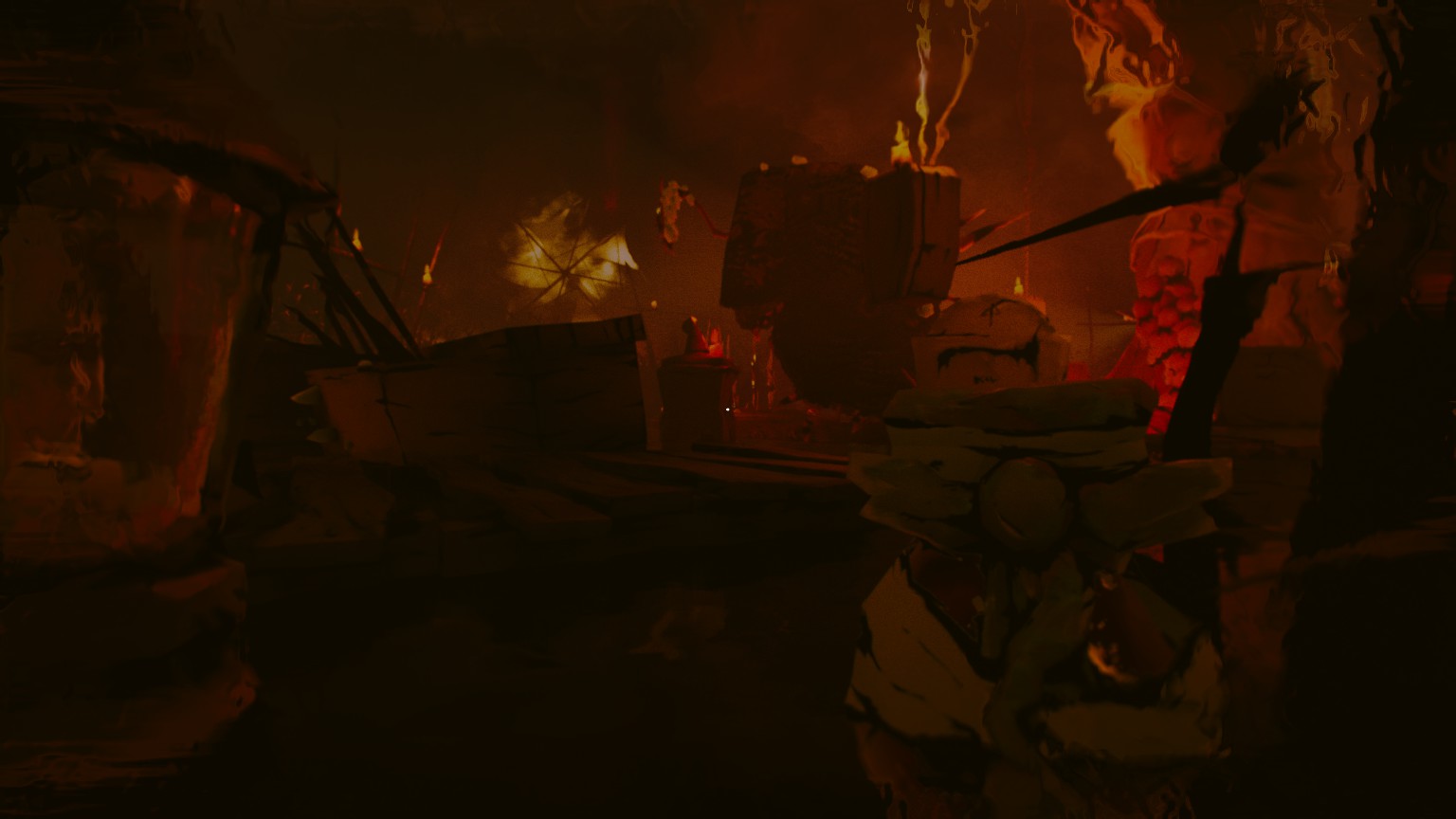
Frightful Farming
Make no mistake, I appreciate the way Harvest Hunt wants to cater to different playstyles and approaches. In this case though, I found myself reluctant to use a lot of the more interesting tools, simply because the mechanics didn’t feel quite tight enough for me to trust giving up the vigor for them. Even so, the core loop is tense and engaging, while the card system is a real boon. Even when they are making my life a misery.
Harvest Hunt’s unique aesthetic style also took me by surprise. The styling of textures and almost watercolour fluidity is really cool. The point-of-view gave me a nod of Dishonored, which is quite honestly never a bad comparison. From the scorching red hue that exudes from a nightmarish tree, to the shift in colour scheme as you traverse a pit of blood and bones, it all screams atmosphere.
The Fiends are creepy and the snap of orchestral strings upon detection vibes like all the best horror tropes. I can certainly foresee streamers having a great time showing this game off to their audiences, suspense and all. Villainous Games clearly had a vision for the look of this game, and they smash the folklore, tales of nightmarish entities inspiration.
The Devourer itself is also that perfect amalgamation of shadowy body, mask-adorned lack of face and terrifying echoey screaming sound effect. You know when this thing is near you and trust me, you’ll rue every second it’s nearby. Never mind the fact you need to extinguish your only light source whenever it’s nearby…
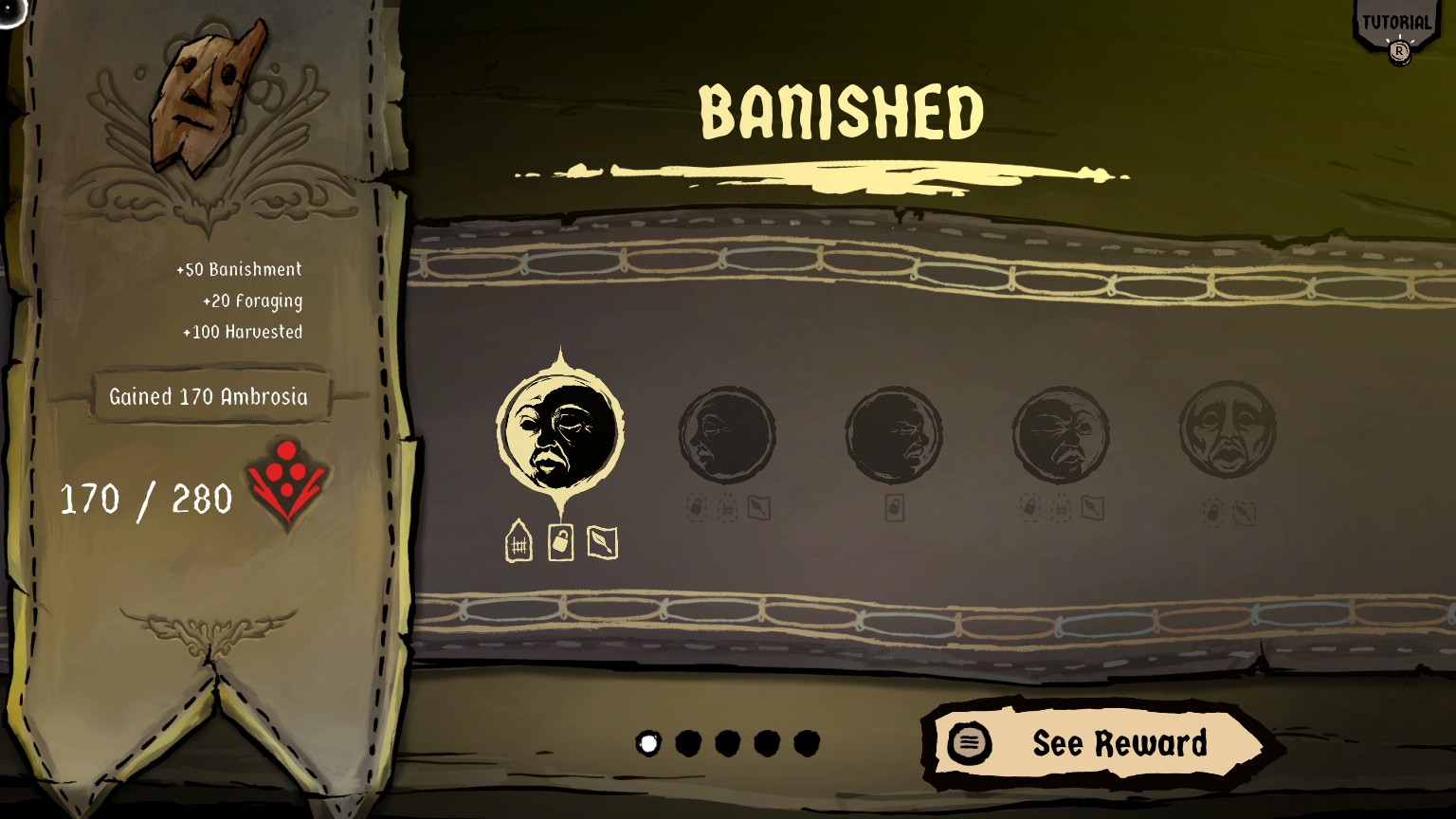
Harvest of Nightmares
Harvest Hunt was truly a half-and-half experience for me. On one hand, it’s a superbly thrilling, tension-driving rogue-lite with awesome card modifiers and a brilliant atmosphere. On the other, it’s an imbalanced and sometimes inconsistent game that can become bothersome and repetitive too quickly. I think what’s most important is how the game will be supported in the future.
Even if one or two more maps were added, with some variations in The Devourer itself would make a big difference. Most of the problems I found with the balancing may not affect everyone the same way, and some can be tweaked relatively harmlessly with feedback. There’s some real scope for this to become a horror rogue-lite gem, but this harvest needs time to bloom.
If more can be added and the gameplay can be diversified in meaningful ways through further content or DLC, I’m certain Villainous Games can craft something special. The start of this folklore ritual has a solid foundation of blood and belief, but the middle is lacking that oomph to make it a cacophony of terror – for now.
I genuinely hope it can fulfil its potential, as the love poured into this indie title is clear to see. Here’s hoping, or rather, here’s nightmare-ing?
Harvest Hunt sows some excellent horror rogue-lite seeds with an interesting folklore background, brilliant card modifiers and a suffocating atmosphere. The growth is unfortunately stunted through a lack of variety and some cheaper horror tactics, but with perseverance and post-launch support, I have confidence the devs can harvest a true indie horror classic, once the blood moon reaches its peak.

Harvest Hunt is available on May 22nd for PC via Steam (review platform).
Developer: Villainous Games Studio
Publisher: Neonhive Games
Disclaimer: In order to complete this review, we were provided with a promotional copy of the game. For our full review policy, please go here.
If you enjoyed this article or any more of our content, please consider our Patreon.
Make sure to follow Finger Guns on our social channels –Twitter, Facebook, Twitch, Spotify or Apple Podcasts – to keep up to date on our news, reviews and features.
